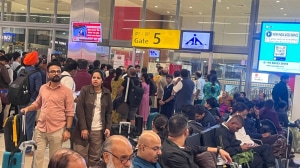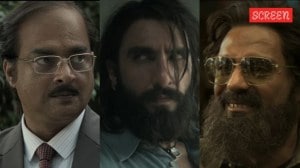Decode Politics: As cross-voting cloud looms on Rajya Sabha polls, how open ballot came up as solution
MLAs choosing Upper House MPs would have to show their vote to party representatives, but that hasn't checked cross-voting. This time, the possibility could arise in Karnataka, UP, Himachal
 The Rajya Sabha elections for 56 seats from 15 states, which are falling vacant in April, will be held on February 27. (Express photo by Prem Nath Pandey)
The Rajya Sabha elections for 56 seats from 15 states, which are falling vacant in April, will be held on February 27. (Express photo by Prem Nath Pandey) The Rajya Sabha elections for 56 seats from 15 states, which are falling vacant in April, will be held on February 27. These states include Uttar Pradesh (10 vacancies) as well as Maharashtra and Bihar (6 vacancies each). For these 56 seats, 59 candidates are in the race — with one extra candidate than the parties can win as per their numbers in Karnataka, Uttar Pradesh and Himachal each.
While the BJP has fielded the extra candidate in Uttar Pradesh and Himachal, its ally JD(S) has done so in Karnataka, raising apprehensions of cross-voting.
Unlike the Lok Sabha and Assembly elections, where ballots are secret (no one can be shown whom the vote is cast for), the Rajya Sabha polls are “open”. This means that the votes that the MLAs of each state cast to choose the members of the Upper House are seen by their party representatives.
But this was not always the case. An election in Maharashtra in 1998 led to the change in the voting process.
First, how are Rajya Sabha members elected?
Rajya Sabha, or the Council of States, has 245 seats. Of these, 12 are nominated by the President and 233 are representatives of states and the Union territories of Delhi and Puducherry.
Rajya Sabha MPs are elected by MLAs through an indirect election. Article 80(4) provides that members shall be elected by the elected members of state Assemblies through a system of proportional representation (made on the basis of the population of each state) by means of a single transferable vote.
Rajya Sabha elections could, therefore, be foregone conclusions, with elections being held unopposed and all party candidates sailing through. This is because each party knows how much strength they have in terms of the votes of their MLAs and can field the requisite number of candidates as per those numbers. In fact, these polls were often a test of party loyalty.
However, parties can field an extra candidate in the hope of getting another member to Parliament. This essentially necessitates a contest and opens up the possibility of cross-voting of MLAs.
How could cross-voting play out?
For example, in the forthcoming Rajya Sabha polls in UP, 10 seats are vacant. The state has 399 MLAs at the moment. As per the proportional representation system, each candidate in UP requires at least 37 votes to win.
The BJP has 252 MLAs and its NDA allies account for 34 MLAs – 13 from the Apna Dal, nine from the Rashtriya Lok Dal (RLD), six each from the NISHAD Party and the Suheldev Bharatiya Samaj Party (SBSP). The Jansatta Dal Loktantrik, which has two MLAs, is also expected to vote in favour of the BJP.
If the BJP manages to get all these 36 votes from its allies, in addition to its own votes, its total number of votes will reach 288. However, the BJP has fielded eight candidates, meaning the party will now need 296 votes (37 multiplied by 8). The BJP will fall short hence by eight votes, setting the stage for cross-voting, potentially by SP members, who want to elect 3 MPs of its own.
What happened in the 1998 election in Maharashtra?
Seven contenders were in the fray for six seats. The Congress had fielded two candidates — Najma Heptullah, who had served three terms in the Upper House, and Ram Pradhan, a former Maharashtra-cadre IAS officer and ex-Union home secretary. The (united) Shiv Sena’s candidates were its sitting MP Satish Pradhan and media personality Pritish Nandy. Senior leader Pramod Mahajan, who had lost the Lok Sabha elections earlier that year, was the BJP’s candidate.
There were two Independent candidates as well: media baron Vijay Darda, whom the Congress supported, and former railway minister Suresh Kalmadi, whom the Shiv Sena supported.
The Congress had enough votes to ensure the victory of both its candidates. But in a surprising turn of events, Congress candidate Ram Pradhan, a close aide of Sonia Gandhi, lost. An Independent candidate sailed through.
The votes cast by MLAs at this point were secret. Congress MLAs had clearly defied their party’s voting instructions, causing Pradhan’s defeat. Reports suggested that legislators from other parties had also cross-voted.
Chakhsu Roy, the head of outreach at PRS legislative research, wrote in an earlier column for The Indian Express that “Pradhan’s loss reverberated in all political circles to a point that parties started thinking about steps to rein in their MLAs”.
An Ethics Committee of the Rajya Sabha that was set up in 1997, headed by Rajya Sabha MP and former Maharashtra Chief Minister S B Chavan, to come up with a solution.
What was the solution proposed?
In its first report in December 1998, the committee observed that money and muscle power played an increasing role in Rajya Sabha elections, suggesting: “In order not to allow big money and other considerations to play mischief… the Committee is of the view that instead of a secret ballot, the question of holding the elections to the Rajya Sabha and the Legislative Councils in states by open ballot may be examined.”
In 2001, then law minister Arun Jaitley introduced a Bill, bringing an amendment to the Representation of the People Act, so that the Rajya Sabha polls could be held by open ballot.
Since then, leaders who cross-vote in the Rajya Sabha polls can be expelled by their party.
Other instances of cross-voting
Most recently, in June 2022, the BJP bagged two Rajya Sabha seats in Haryana (for which three candidates were fielded) because of cross-voting by then Congress leader Kuldeep Bishnoi. While other leaders went on to vote for their party nominees, showing their votes to their election agent, Bishnoi, who was the Congress MLA from Adampur, said he had “voted as per his inner conscience” and “did not vote for Congress nominee Ajay Maken”. Bishnoi was expelled — and he went on to join the BJP.
In the same Upper House poll cycle, the BJP in Rajasthan expelled its MLA Shobharani Kushwah for cross-voting in the Rajya Sabha polls days after she was sent a showcause notice.
Earlier, in June 2016, the Congress in Uttar Pradesh expelled six MLAs after they cross-voted for the BJP in the then Rajya Sabha polls.
In August 2017, Congress leader Ahmed Patel got elected to the Upper House after a dramatic set of events.
The Congress had at the time filed two applications for rejection of votes tendered by two MLAs for violating the polling procedures. The party claimed the MLAs had shown their ballot papers to Amit Shah (who was among the Rajya Sabha) MPs elected from Gujarat that year. The petition was first rejected by the Returning Officer.
On rejection, a delegation of Congress leaders met with Election Commission officials in New Delhi and raised objections to the RO’s decision. The EC took into consideration the Congress’ plea and declared that the two MLAs had violated polling procedures and secrecy of the ballot. The two votes were disqualified, — and the number of votes required were brought down from 46 to 44. Patel had the 44 votes and he secure a fifth term in the Rajya Sabha.
- 01
- 02
- 03
- 04
- 05































